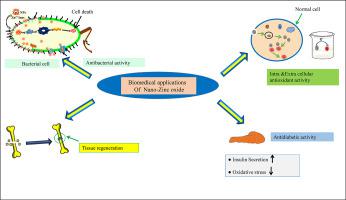Advances in Colloid and Interface Science ( IF 15.6 ) Pub Date : 2021-07-25 , DOI: 10.1016/j.cis.2021.102495 Th Abhishek Singh 1 , Anirudh Sharma 1 , Neeraj Tejwan 1 , Noyel Ghosh 2 , Joydeep Das 3 , Parames C Sil 2

|
Recently, zinc oxide nanoparticles (ZnONPs) are gaining much interest of nanobiotechnologists due to their profound biomedical applications. ZnONPs are used as antibacterial agents, which cause both gram-positive and negative bacterial cell death through the generation of reactive free radicals as well as membrane rupture. ZnONPs show excellent antioxidant properties in normal mammalian cells via the scavenging of reactive free radicals and up-regulation of antioxidant enzyme activities. Besides, it also shows hypoglycaemic effect in diabetic animals via pancreatic β-cells mediated increased insulin secretion and glucose uptake by liver, skeletal muscles and adipose tissues. Among the other potential applications, ZnONPs-induced bone and soft-tissue regeneration open a new horizon in the field of tissue engineering. Here, first we reviewed the complete synthesis routes of ZnONPs by physical, chemical, and biological pathways as well as outlined the advantages and disadvantages of the techniques. Further, we discussed the several important aspects of physicochemical analysis of ZnONPs. Additionally, we extensively reviewed the important biomedical applications of ZnONPs as antibacterial, antioxidant, and antidiabetic agents, and in the field of tissue engineering with special emphasis on their mechanisms of actions. Furthermore, the future perspectives of the ZnONPs are also discussed.
中文翻译:

氧化锌纳米颗粒的合成、抗菌、抗氧化、抗糖尿病和组织再生活性的最新进展
最近,氧化锌纳米颗粒 (ZnONPs) 由于其广泛的生物医学应用而引起了纳米生物技术专家的极大兴趣。ZnONPs 被用作抗菌剂,通过产生反应性自由基和膜破裂导致革兰氏阳性和阴性细菌细胞死亡。ZnONPs 通过清除活性自由基和上调抗氧化酶活性,在正常哺乳动物细胞中显示出优异的抗氧化特性。此外,它还通过胰腺 β 细胞介导增加肝脏、骨骼肌和脂肪组织的胰岛素分泌和葡萄糖摄取,在糖尿病动物中显示出降血糖作用。在其他潜在应用中,ZnONPs 诱导的骨和软组织再生为组织工程领域开辟了新的视野。这里,首先,我们通过物理、化学和生物途径回顾了 ZnONPs 的完整合成路线,并概述了这些技术的优缺点。此外,我们讨论了 ZnONPs 理化分析的几个重要方面。此外,我们广泛回顾了 ZnONPs 作为抗菌剂、抗氧化剂和抗糖尿病剂的重要生物医学应用,以及在组织工程领域中的重要应用,特别强调了它们的作用机制。此外,还讨论了 ZnONP 的未来前景。我们广泛回顾了 ZnONPs 作为抗菌剂、抗氧化剂和抗糖尿病剂的重要生物医学应用,以及在组织工程领域中的重要应用,特别强调了它们的作用机制。此外,还讨论了 ZnONP 的未来前景。我们广泛回顾了 ZnONPs 作为抗菌剂、抗氧化剂和抗糖尿病剂的重要生物医学应用,以及在组织工程领域中的重要应用,特别强调了它们的作用机制。此外,还讨论了 ZnONP 的未来前景。



























 京公网安备 11010802027423号
京公网安备 11010802027423号